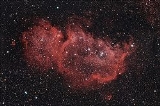
Soul Nebula
Encyclopedia
Soul Nebula is emission nebulae in Cassiopeia
. Several small open clusters are embedded in the nebula: CR 34, 632, and 634 (in the head) and IC1848 (in the body). The object is more commonly called by the cluster designation IC1848.
Small emission nebula IC 1871 is present just left of the top of the head, and small emission nebulae 670 and 669 are just below the lower back area.
This complex is the eastern neighbor of IC1805 (Heart Nebula
) and the two are often mentioned together as the "Heart and Soul".
, the carving out of these cavities pushes gas together, causing it to ignite into successive generations of new stars. The image in the gallery above contains some of the best evidence yet for the triggered star formation theory. Scientists analyzing the photo have been able to show that the ages of the stars become progressively and systematically younger with distance from the center of the cavities.
Cassiopeia (constellation)
Cassiopeia is a constellation in the northern sky, named after the vain queen Cassiopeia in Greek mythology, who boasted about her unrivalled beauty. Cassiopea was one of the 48 constellations listed by the 2nd century Greek astronomer Ptolemy, and it remains one of the 88 modern constellations today...
. Several small open clusters are embedded in the nebula: CR 34, 632, and 634 (in the head) and IC1848 (in the body). The object is more commonly called by the cluster designation IC1848.
Small emission nebula IC 1871 is present just left of the top of the head, and small emission nebulae 670 and 669 are just below the lower back area.
This complex is the eastern neighbor of IC1805 (Heart Nebula
Heart Nebula
The Heart Nebula, IC 1805, Sh2-190, lies some 7500 light years away from Earth and is located in the Perseus Arm of the Galaxy in the constellation Cassiopeia. This is an emission nebula showing glowing gas and darker dust lanes...
) and the two are often mentioned together as the "Heart and Soul".
Star formation
W5, a radio source within the nebula, spans an area of sky equivalent to four full moons and is about 6,500 light-years away in the constellation Cassiopeia. Like other massive star-forming regions, such as Orion and Carina, W5 contains large cavities that were carved out by radiation and winds from the region's most massive stars. According to the theory of triggered star formationStar formation
Star formation is the process by which dense parts of molecular clouds collapse into a ball of plasma to form a star. As a branch of astronomy star formation includes the study of the interstellar medium and giant molecular clouds as precursors to the star formation process and the study of young...
, the carving out of these cavities pushes gas together, causing it to ignite into successive generations of new stars. The image in the gallery above contains some of the best evidence yet for the triggered star formation theory. Scientists analyzing the photo have been able to show that the ages of the stars become progressively and systematically younger with distance from the center of the cavities.

